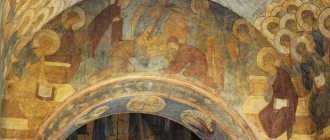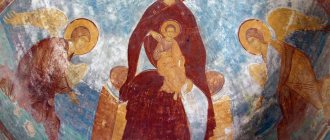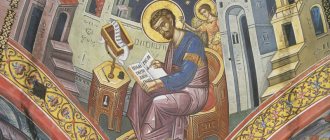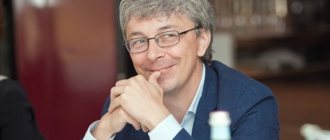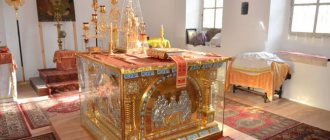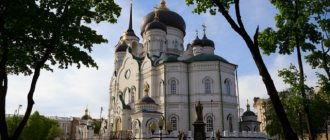Theological problems
Icons in Ancient Rus' occupied a central place in temple art. They reflected Divine Beauty - the Image of God was imprinted, and everything worldly and earthly remained outside the image.
The art of icon painting in ancient times was subject to clear and precise criteria that were developed by the holy fathers of the Church. It is the canon that allows us to capture the Image of God, preventing the icon from being turned into a painting or portrait. And it makes it possible to convey the Image of God to every believer in an undistorted form.
What's happening today? Most often, the works of modern icon painters are evaluated according to the criteria of painting on a religious theme, discussing composition, color and the individual vision of the painter. And it is extremely difficult for an artist whose professionalism was formed in the conditions of de-churched painting to abandon creative individuality and create in accordance with the canonical requirements of Orthodox painting.
But is it acceptable for an icon to reflect the artist’s personal vision? The answer to this question is clearly negative, since the believer wants to see precisely the authentic Image of God in the iconographic image. And therefore, it is important for the icon painter not to achieve self-expression, but to create the Holy Face in strict accordance with the patristic canons, without the admixture of personal vision. And this is another reason why you will not find the name of the painter on ancient icons. Where the Spirit reigns, there is no place for the artist’s personal “I”.
Today there are practically no schools of Russian canonical church art. And this is one of the main problems of our time. In fact, artists have no place to study the meaning of the canons, and this leads to the inability to comprehend ancient iconography and comprehend artistic techniques. And as a result, icon painting in many cases comes down to a banal “copying” of ancient images. Moreover, copying is often carried out without correction of the composition, not to mention the internal meaning.
LiveInternetLiveInternet
Quote from the message you want_to_see_beauty
Read in full In your quotation book or community!
The spirit of an icon painter cannot be hidden behind beautiful words... Artist Maxim Sheshukov
We, people of the 21st century, simply have not really seen ancient Russian icon painting. The frescoes and mosaics that survived in the ancient churches darkened, became covered with dust and soot, and the icons - the main, most numerous part of the ancient Russian heritage - literally became invisible. After all, not every church was decorated with frescoes and especially mosaics in ancient times, and there were icons not only in every temple, but also in every home. The technique in which they were created was special. The board on which the icon was to be written was covered with gesso or primed cloth - pavoloka, and the image itself was applied to the ground with tempera, i.e. mineral paints. And on top the image was covered with a layer of drying oil. It is this ancient method that Sviyazhsk icon painters use in their works...
Maxim Sheshukov, a modern icon painter, has been working on icons since the early nineties. He works and lives in Sviyazhsk, an ancient city founded on an island by Ivan the Terrible a few kilometers from Kazan. He himself was originally from Kazan, but moved to Moscow, studied icon painting in the workshop of Vladimir Ivanovich Shcherbinin at the Sretensky Monastery in Moscow, got married, and got an apartment. It seemed like a big city, the center of Russia, live and be happy, but... Somehow friends advised him to buy a house in Sviyazhsk and settle far from the stalls and the “market economy”, where living and real life remained untouched. Then other artists began to buy houses here, slowly create their own studios, and a colony of creative eccentrics began to take shape on its own, a kind of cultural enclave.
“Artists are like bedbugs; they cannot be destroyed. Artists are God’s project - that’s why I believe in God... I’m no longer a young man and I no longer deal with the pains of creativity, I only deal with free creativity: take a hammer and a nail, hammer a nail into the wall - without experiencing any pain and there is - real creativity..."
Sheshukov always talks about the work of an icon painter, in any interview, as routine and everyday, down to earth and deliberately reducing its pretentiousness. Nothing lofty, but the most earthly is the most real. There is, of course, truth in his words, if we consider the work of an icon painter as limited by strict canons and frameworks. Boards for icons should be selected in a special way, and not just how; paints are only real, mineral, made from earth and stone, and no chemicals. The boards are also processed using a special technology. And all according to old samples, old technologies and recipes from five centuries ago. Maxim Sheshukov has his own team of five people: one prepares the boards, another prepares the paints, the third draws, and the icon painter simply “paints.” This is how icon painting workshops have been built in Rus' for a long time.
But there is also slyness in the icon painter’s words, because the most important thing in icon painting is not technical techniques and craft. An icon is born only when thought, spirit and life are also real, not fake, not invented and not dressed up as Russian antiquity. The icon reveals the invisible - the spirit of the icon painter, which cannot be hidden behind beautiful words. It is evident here and on the faces. “It’s like in music: there are notes, and there are performers. Any icon painter is, in essence, a performer. It all just comes down to performance skill. Richter will perform one thing, another thing - some tavern musician... After all, there is a wide range of some possibilities: someone works on virtuoso honing, someone follows a completely central line - according to the notes... So it is with us. And the icon painting workshop itself is always several people. Like some small orchestra...
This is how the icon painter modestly and in a few words talks about what he does every day: he simply plays the notes. Maxim's creativity is not limited to icon painting. He also makes ceramics and paints. And again he compares this with music: “An icon is a specific musical notation, and radical icon-like paintings are a different area. Another piece of music. Everything is like in music... There are canonical things and there are abstract ones...” Looking at his icons, you understand that the Russian icon painting tradition has not died, it is being reborn, alive and real.
Girl with three wings
The stoning of Stephen
Problems of technical skill
Another problem of modern icon painting is that today in churches you often find icons painted by self-taught artists. Lack of understanding of the complex system of religious painting often leads to the fact that the created images look more like posters.
The main idea of icon painting is the manifestation of the Image of God through material objects, in this case icons. For this, a special “sankir” technique is used. It differs from ordinary secular painting in that the revelation of the image begins with the darkest shades, onto which white is gradually superimposed.
If ordinary paintings are painted quickly and generally, then icons are created over a long period of time and with special care. Drawing images in accordance with the canons is of great importance, since they bear the main artistic burden. And any mistake in a linear drawing will be visible immediately, so the icon painter should not rush.
Industrially produced paints made from chemical components are not very suitable for creating the Image of God. They do not allow obtaining the desired depth and transparency of shades, which give iconographic images a special radiance. And that is why real icon painters even today grind natural minerals to obtain paints, mixing them with egg emulsion, as was done centuries ago.
One of the main tasks of the icon is an attempt to direct our human nature towards the path of transformation.
Archbishop of Syracuse and Trinity Averky (Taushev) wrote: “Iconography should not remind the person praying of anything earthly, but on the contrary, it should distract his thoughts and feelings from everything earthly and transfer him to the heavenly world, the spiritual world.” Opinions about the Christian image and specifically about the icon are not new. Most likely, they take their basis from centuries-old Christological disputes about the Face of the Savior. This includes the confrontation between iconoclasts and icon worshipers. Questions about Christian art were raised at the Ecumenical Councils, the last of which proved a complete dogmatic and canonical victory over opponents of iconography. Having a huge baggage of wonderful patristic works devoted to the Christian image, today we, unfortunately, are faced with a misunderstanding or lack of basic knowledge and basics about the “theology of the icon.” Some, even churchgoers, perceive the icon more as a tradition, not realizing that one of the main tasks of the icon is an attempt to direct all our feelings, mind and all of our human nature onto the path of transformation.
Low artistic level
Lack of artistic skill and knowledge of the canons is the scourge of modern icon painting. Amateur icon painters are often guided by religious vanity and are extremely intolerant of criticism. Not mastering the art of canonical painting, they even try to “improve” ancient iconography and introduce new, unnecessary details into them, which are gross canonical violations. Without a doubt, today there are real masters of icon painting who create icons comparable to ancient images. Their creative level is the bar to which all icon painting schools should strive.
The teaching of the Church can be distorted not only by word, but also by “image”
Some people see spiritual revival as a kind of restoration of church traditions, which have not been tested by time and often lead to the destruction of canonical Christian painting. This, in turn, can lead the faithful astray instead of edifying. The teaching of the Church can be distorted not only by word, but also by “image.” Today there is a great diversity in the manner of writing Christian images and subjects: some write in the manner of Byzantine art, some revive the writing of Russian icon painting schools, some in their work rely on Baroque style, etc. Such a number of artistic movements could not bypass the idea of creating an “avant-garde icon.” The basics of this kind of painting are well covered in the work of V.V. Bychkov. “Icon and Russian avant-garde early. XX century".
The avant-garde does not contain the idea of “pouring the Heavenly World into our world, the world below”
If we trace the history of the formation of the Russian avant-garde, then it was the “discovery” of Byzantine and Old Russian iconography during the “Silver Age” that gave a huge impetus to a number of trends and techniques that were used by avant-garde artists of the 20th century. For example, the avant-garde in iconography borrowed the technique of “reverse perspective,” but in this case the avant-garde does not contain the idea of “pouring the Heavenly World into our world, the world below.” In the medieval art of Europe and Rus', the culture of “popular painting” was widespread, and Christian themes were often depicted. Perhaps the roots of the “avant-garde icon” should be looked for there.
Therefore, these images are a modern popular print on a religious theme with obvious elements of the avant-garde and its wonderful varieties. And it is perceived by a religiously enlightened person only in this context. Like any art, “popular painting” has the right to exist, it has its admirers - and thank God. The main goal of Christian fine art is creation, cultural and spiritual development of the individual. And if a given artistic direction is acceptable to a person and brings “positivity,” let the person aesthetically enjoy it at home or at work. I would like to end with the words of the talented artist, the founder of Russian Art Nouveau, Viktor Mikhailovich Vasnetsov: “My painting is only a weak reflection, moreover, emasculated, of the very rich world of ancient Russian icons...”


